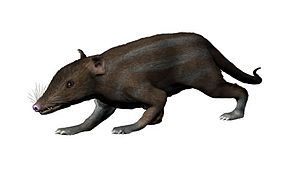Juramaia sinensis
| Juramaia sinensis | ||||||||||||
|---|---|---|---|---|---|---|---|---|---|---|---|---|

Juramaia sinensis |
||||||||||||
| Temporal occurrence | ||||||||||||
| Upper Jurassic | ||||||||||||
| 160 million years | ||||||||||||
| Locations | ||||||||||||
| Systematics | ||||||||||||
|
||||||||||||
| Scientific name of the genus | ||||||||||||
| Juramaia | ||||||||||||
| Luo , Yuan , Meng & Jiet , 2011 | ||||||||||||
| Scientific name of the species | ||||||||||||
| Juramaia sinensis | ||||||||||||
| Luo et al., 2011 | ||||||||||||
Juramaia sinensis is an extinct species of mammal . It is the only known representative of the genus Juramaia and lived around 160 million years ago in the early Upper Jurassic of Central Asia . Juramaia sinensis shows similarities with modern placenta in the structure of the skeleton and teeth, which is why it is considered the earliest representative of this group. The structure of the forelegs suggests that the shrew- sized Juramaia sinensis was a tree dweller.
The fossil of Juramaia sinensis serving as the holotype comes from the Tiaojishan Formation in the Chinese province of Liaoning and was first described in 2011 by Zhe-Xi Luo , Chong-Xi Yuan , Qing-Jin Meng and Qiang Ji .
features
Juramaia sinensis had an elongated, pointed head with a narrow jaw and was furry . The skull measured about 22 mm in length and about 10 mm in width, the jaw was about 17 mm. The front feet were about 10 mm long. The weight of the animal was 13-15 g. The tooth formula is I 5/4 - C 1/1 - P 5/5 - M 3/3. This tooth formula is identical to that of the Cretaceous Eomaia scansoria - also an early placenta. The five pre- molars and three molars are also typical of later Cretaceous placenta animals. The mandible foramen is not at the level of the first molar as in marsupials, but between the fourth and fifth premolars, as is the case with most placentates.
Under the toe bones of the front feet, the first and second phalanxes are relatively long. On the third phalanx they are together 1.21 times as long as the corresponding metacarpal bone, which corresponds to a phalangeal index of 121. The proximal phalanx index, that is a hundred times the ratio of I. to II. Phalanx, is 65; the middle toe bones are also relatively long.
Way of life
Due to its tooth structure, Juramaia sinensis most likely fed on insects . The long toe bones suggest that Juramaia sinensis had the ability to climb trees. Almost all recent mammals and especially rodents with similar phalangeal indices are tree dwellers. While most of the known mammals of the Jura were ground dwellers, Juramaia sinensis apparently occupied a new ecological niche.
Taxonomy and systematics
Locality of Juramaia sinensis
|
The first description of the species by Zhe-Xi Luo , Chong-Xi Yuan , Qing-Jin Meng and Qiang Ji was published in the journal Nature in August 2011 . The generic name Juramaia means “Juramother” (with reference to the ancestrality of the species), the epithet sinensis “from China”. The holotype ( BMNH PM1343) comes from the Daxigou site of the Tiaojishan Formation in the Chinese province of Liaoning . It consists of a partially preserved fossil, with parts of the skull and abdomen missing, but the upper body and teeth completely and traces of the fur partially preserved.
Juramaia sinensis is classified into the higher mammals or placenta animals (Eutheria) due to its clear tooth structure and represents their earliest known representatives. The earliest known placenta animal up to the description of the species was the approximately 125 million year old Eomaia scansoria from the Lower Cretaceous . The oldest member of the marsupials (Metatheria) found, Sinodelphys szalayi , is roughly the same age. The splitting of the theria into placentas and marsupials must be brought forward 35 million years due to the discovery of Juramaia sinensis . This allows models for DNA analysis of both groups to be better calibrated. In addition, the existence of a placenta in the Upper Jurassic suggests that pouches and mammals must have existed in the Middle Jurassic . The fact that both the earliest representatives of the placenta animals and the marsupials had the ability to climb indicates a key role this property played in the separation of the two groups from the early mammals.
The position of Juramaia sinensis within the placenta is unclear. Although it is a basal representative, the relationship to other basal placentates is unknown.
The relationships between Juramaia sinensis according to Luo et al. 2011 are shown in the following cladogram:
|
|
|
|||||||||||||||||||||||||||||||||
|
|
swell
literature
- Zhe-Xi Luo, Chong-Xi Yuan, Qing-Jin Meng, Qiang Ji: A Jurassic Eutherian Mammal and Divergence of Marsupials and Placentals. In: Nature. 476, August 25, 2011. doi : 10.1038 / nature10291 , pp. 442-445.
- Zhe-Xi Luo, Chong-Xi Yuan, Qing-Jin Meng, Qiang Ji: Supplementary Information. In: Nature. 476, August 25, 2011. doi : 10.1038 / nature10291 , pp. 1–150.
Individual evidence
- ↑ a b c Luo et al. 2011a , p. 442.
- ↑ Luo et al. 2011b , p. 2.
- ↑ Luo et al. 2011b , p. 4.
- ↑ Luo et al. 2011b , pp. 4-5.
- ↑ a b c Luo et al. 2011a , p. 444.
- ↑ Luo et al. 2011a , p. 445.
- ↑ a b Luo et al. 2011a , p. 443.
